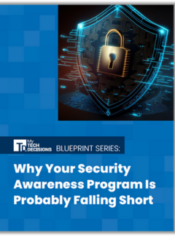Red Hat is holding its annual Red Hat Summit event this week and judging by the enterprise open source software giant’s product announcements, the company is keying in on AI, automation, security and productivity enhancements.
Like other tech giants, the company used its event to make important announcements in generative AI to help accelerate its enterprise adoption with Red Hat OpenShift AI, as well as several new capabilities in its automation platform Ansible.
The company is also focusing on simplifying management for Red Hat Enterprise Linux and securing the software supply chain.
Let’s look at the more notable announcements from the Raleigh, North Carolina-based tech firm’s announcements at its Red Hat Summit event in Boston, Mass.:
Red Hat OpenShift AI and Generative AI
According to Red Hat, the company is building and expanding upon the capabilities of OpenShift and OpenShift Data Science with OpenShift AI to give IT operations leaders, data scientists and developers a unified solution to train, serve, monitor and manage the lifecycle of artificial Intelligence (AI) and machine learning (ML) models and applications.
The company says Red Hat OpenShift AI underpins the generative AI services of IBM watsonx.ai, IBM’s new AI platform designed to scale intelligent applications and services across all aspects of the enterprise.
Red Hat says OpenShift AI solves a few key issues: the infrastructure-intensive training of AI models and requirement of specialized platforms and tools before serving, tuning and managing the model. OpenShift AI provides the infrastructure consistency across training, deployment and difference, the company says.
OpenShift AI provides a standardized foundation for creating production AI/ML models, as well as running the resulting applications, along with the ease-of-use and cloud-to-edge deployment options of OpenShift, the company says.
OpenShift AI provides several technology partner offerings, including Anaconda, IBM Watson Studio, Intel OpenVINO and AI Analytics Toolkit, NVIDIA AI Enterprise and Starburst, as well as 30 additional certified partners as part of the OpenShift ecosystem.
Customers with regulatory and compliance requirements, including air-gapped and disconnected environments can use OpenShift AI on -premises, while customers can also develop models in the public cloud and deploy them on-premises or at the edge, the company says. This provides a unique hybrid MLOps environment that enables collaboration between IT, data science and application developers, the company says.
According to Red Hat, new enhancements to OpenShift AI include deployment pipelines for AI/ML experiment tracking and automated ML workflows, model serving with GPU support for inference and custom model serving runtimes, and model monitoring to help organizations manage performance.
Ansible Lightspeed with IBM Watson Code Assistant
OpenShift AI, Red Hat says, is the base of IBM’s new AI enhancements including IBM Watson Code Assistant, to deliver domain-specific AI to IT organizations and developer teams.
This is done by bringing IBM Watson Code Assistant to Ansible, giving users the ability to write Ansible Playbooks with AI-generated recommendations. This new service is designed to help drive consistent and accurate automation adoption across an organization, the company says.
According to Red Hat, Ansible Lightspeed is the next phase of its Project Wisdom initiative, making it available to users, contributors, customers and Red Hat’s partner ecosystem. The service integrates with Watson Code Assistant, which will be available later this year. This allows access to IBM foundational models to quickly build automation code.
Event-Driven Ansible
Sticking with the IT automation theme, Red Hat also announced Event-Driven Ansible, a scalable solution designed to expand how organizations activate automation as a reliable strategy across the hybrid cloud.
The solution, slated for availability in June, is for Red Hat Ansible Automation Platform 2.4 customers; is designed to connect infrastructure and application observability tools with enterprise-grade Ansible automation, helping IT teams to pre-determine and define rules to initiate automated responses to situations like unresponsive system processes or unauthorized access requests.
When an event is trigged, the solution automatically executives the desired action via Ansible Playbooks or direct execution modules, with the ability to chain multiple events together into more complex automation actions, Red Hat says.
Event-Driven Ansible integrates with event sources form third-party monitoring, observability and IT tools, including Cisco ThousandEyes, CyberArk, Dynatrace, F5, IBM Instana, IBM Turbonomic, Palo Alto Networks, with additional partner integrations to follow.
Supplementary Red Hat-developed content is available for Red Hat OpenShift, Red Hat Insights, AWS, Microsoft Azure, Google Cloud Platform and ServiceNow, the company says.
Red Hat Enterprise Linux management
To help organizations better manage Red Hat Enterprise Linux, Red Hat is launching new capabilities in Red Hat Insights to give IT teams more insight and management tools to find and resolve IT issues much faster across the hybrid cloud. The tools are available through any browser via console.redhat.com and are designed to unify the management of Red Hat Enterprise Linux deployments in a single user interface, the company says.
According to Red Hat, these expanded capabilities build on the information provided by existing Red Hat Insights’ predictive analytics, which can detect potential bugs, misconfigurations or security vulnerabilities using Red Hat’s expertise in running Linux platforms in critical production environments.
The enhancements allow IT administrators to fix bugs without needing Red Hat Satellite Server and act on server groups simultaneously using patch templates, as well as build standardized operating system images that comply with organization-specific requirements.
Red Hat Advanced Cluster Security Cloud Service
According to the company, Red Hat Advanced Cluster Security Cloud Service is a new service that brings together Kubernetes-native security capabilities with a fully Red Hat-managed offering to help organizations take a security-forward approach to building, deploying and maintaining cloud-native applications regardless of the underlying Kubernetes platform.
The managed service supports both Red Hat OpenShift on private and public clouds and non-Red Hat Kubernetes services across major cloud providers, including Amazon EKS, Google GKE and Microsoft AKS, bringing security coverage to containerized applications regardless of where they are deployed.
Organizations can scale security capabilities across multiple clusters, whether on-prem or in the cloud while lowering operational costs by reducing the learning curve for implementing Kubernetes-native security without sacrificing necessary capabilities or enforcement, the company says.
Red Hat Trusted Software Supply Chain
Red Hat announced its Trusted Software Supply Chain Solution designed to protect against software supply chain vulnerabilities. The company says two new cloud services, Red Hat Trusted Application Pipeline and Red Hat Trusted Content, are joining in preview mode the existing Red Hat software and cloud services, including Quay and Advanced Cluster Security (ACS), to advance the successful adoption of DevSecOps practices, and embed security into the software development lifecycle.
Essentially, Red Hat Trusted Software Supply Chain allows customers to more efficiently code, build and monitor software using proven platforms, trusted content and real-time security scanning and remediation.
The solution allows customers to import git repositories and configure container-native continuous build, test, and deployment pipelines via a cloud service; inspect source code and transitive dependencies auto-generate Software Bills of Materials and verify and promote container images via a release criteria policy.
Visit the Red Hat Summit newsroom to learn more about these announcements and others.
If you enjoyed this article and want to receive more valuable industry content like this, click here to sign up for our digital newsletters!










Leave a Reply